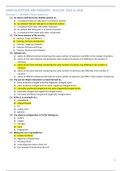Exam (elaborations)
BLG1501 Exam Questions and Answers
- Institution
- University Of South Africa (Unisa)
- Book
- Biology
I have combined all the questions in old BLG1501 exam papers into one document. Each question is answered from the textbook (and further research where necessary) to ensure accuracy. This can be used to give you an idea of the kind of questions that you will be asked, as well as the kind of answers...
[Show more]




